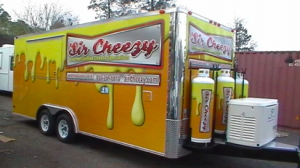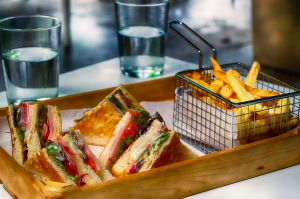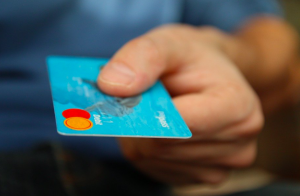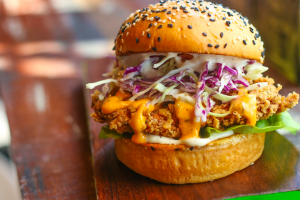In difficult times, identifying ways to deliver more value to the same number of customers can be an effective business approach.
After you’ve been running your food truck for a few weeks or months, you’ll probably start noticing some trends. For example, you may have noticed that on a typical day, you serve 50 customers, but your sales numbers have plateaued.
There are only a few ways to fix these “stalls” in income. You can decrease the amount of money you’re spending on food, but there’s probably not a lot of wiggle room here, without sacrificing quality. You can raise the prices on your menu, but that risks alienating your existing customers and discouraging new business.

A grilled cheese trailer built by M&R Specialty Trailers and Trucks.
You can always try to attract more customers, but frankly, that can be difficult and eventually, there are only so many customers you can serve in a given day, considering the limitations you have on staff and the amount of food you can physically prep and carry for a given day.
Instead, consider leveraging the resource you already have: Your existing customers. It’s often easier to increase the amount each customer spends, rather than attract new customers or cut costs. Here are a few ways to do this:
Low-Effort, Low-Cost Add-Ons

Would you like fries with that?
One of the key concepts to keep in mind here, is finding ways to increase revenue per customer per visit, without increasing the workload on your part. A simple way to do this is with low-effort, low-cost add-ons.
An array of interesting bottled beverages, creative assortments of chips or candy, or packaged baked goods are all great places to start, since they can all be purchased wholesale for little money, marked up considerably, and tossed into a bag to accompany the food you’ve cooked yourself.
Plan your add-ons well, and you could find that your $8 cheeseburger customer is consistently leaving your window with $15 dollars in purchases, with very little in the way of extra cooking or prep time for you.
Breaking Up Menu Items/Making Everyone Pay for Everything
This is going to be different for all food truck owners, and some experimentation is probably in order. But instead of being tempted to group your items into “combo meals” the way fast food restaurants do, make everything on your menu ala cart. This means that, instead of offering a burger, fries, and a drink for $8.95, you price that burger at $6.95.
The fries are $2.95, and the drink is, say, another $2 bucks. Just like that, you’ve changed your customer value from $8.95 to $11.90, in a way that’s probably imperceptible to most customers. What’s more, it helps you control food costs and waste; instead of giving fries to customers who may not want them, you’re only selling food that you know is actually going to be eaten and enjoyed.
Again, this method may not be a good fit across all types of cuisine and in all markets, but in general, experiment with pricing everything individually, instead of in combos or groups.
Merchandise and Gift Card Sales

Offering gift cards is easier than you might think.
One of our favorite ways to dial up the average-spend-per-customer is with fun add-ons that promote your business, including t-shirts and stickers. Think of it this way: A customer who loves your business who stops by for a sandwich also buys a t-shirt, and you’ve instantly changed that single visit from $8 to $28, with no extra work on your part (after the initial effort and expense to design and have your t-shirts printed). What’s more, that customer is now a walking billboard for your business, so there’s additional marketing benefit, as well. Even a sticker with your food truck’s logo can incrementally increase sales per customer.
Gift cards are also a fantastic avenue for any food business looking to increase revenue per visit, without adding extra effort. A customer who buys a taco, and also a $50 dollar gift card for a friend puts an instant $54 dollars into your till, with the secondary benefit of attracting a new customer (the gift card recipient). Just remember that gift cards aren’t free money; they’re more of a no-interest loan that can be called back for repayment at any unspecified point in the future, so be ready when those gift cards start reappearing in your window to be redeemed.
Breaking the 33% Cost Rule
Most of us know by now that we should be hitting a food cost goal of 33%, which loosely means that we should be tripling the price between what we pay for something wholesale, and what we charge customers for that same item. It’s a pretty easy rule to follow; a can of soda that you’re buying for 50 cents, should be sold to your customers for $1.50, in order to accommodate overhead costs, and hopefully put something in your pocket at the end of the day. However, there are exceptions to this rule.
One of my employees actually clued me into this one, particularly for the “low-cost, low-effort” add-ons we described earlier. The theory is this. If you buy a can of Sprite for 40 cents from a wholesale club, you should charge $1.20 for it. There are two big problems with this. The first is that, considering today’s beverage trends, consumers are increasingly turning away from soda, in favor of teas, seltzers, juices, and energy drinks. The second is that, even if that customer buys that can of soda, you’ve only netted 80 cents.
The solution SEEMS like it should lie in offering higher-value drinks, like artisanal bottled iced tea, or energy drinks. However, most of these drinks wholesale in the $1-2 range, which means that according to the 33% rule, they’d have to be priced at $6 or more, which is a high price most customers aren’t willing to pay for a single drink. So what’s a food truck operator to do?
As my erstwhile young staffer explained, you break the 33% rule. You offer the $2 wholesale priced beverage on your truck for $4, or a price customers can handle. Sure, you don’t hit your margin goals on that drink, but on that single beverage, you net $2, which still beats the 80 cents you made on the can of Sprite that nobody wanted. And two bucks is always better than 80 cents.
Breaking the 33% Cost Rule: Part 2

A fried chicken burger: High-Margin item.
There are other times when it’s appropriate to break the 33% cost rule, and that’s on menu items that are low in cost, with a high perceived value. For one season on my truck, my entire menu was built around fried chicken sandwiches, with different toppings and sauces.
Why? Because the margins were outrageous, on an inexpensive item with a high perceived value. At that time, a bone-in, skin-on chicken thigh cost about 60 cents, wholesale.
Even with a fancy bun, some vegetables, and a creative sauce or two, my cost “on the plate” was still only around a buck and a half. Does that mean I sold that sandwich for $4.50, according to the 33% cost rule? Hell no. Because of the high perceived value of a gourmet fried chicken sandwich, I was able to list it on my menu for $8.95, which meant that on each sandwich sold, I was earning a whopping $7.45, a markup of around 496%. Not bad.
As you plan your menu, try to identify areas in which you can score bargain-priced ingredients with a high perceived value, and when you find them, feel free to break the 33% rule, to your advantage.
Conclusion
Learning to make money in the food truck business, or increase the revenue that’s already coming in, is an ongoing process of experimentation and mixed results.
But that’s one of the reasons we love the food truck business; your ability to be nimble, try new ideas and theories, and pivot when sales aren’t going your way can’t be matched by restaurateurs trapped in a brick-and-mortar space. Don’t be afraid to test theories and changes; you’ll have nearly real-time results that will make it abundantly clear in a very short amount of time, whether or not your efforts are driving results.

Leave A Comment